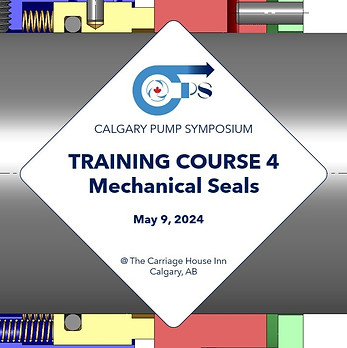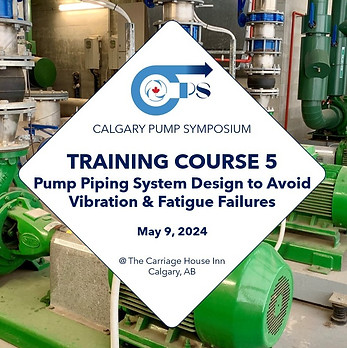2026 Training Courses
- May 7, 2026 -
The 2026 Calgary Pump Symposium will host 6 full day paid training courses on May 7th, 2026, the topics of which are outlined below. Once the instructors have been finalized this page will be updated with their information.
The 2026 course offerings are:
Course 2 - Pumps 101 - Fundamentals
Course 3 - Electric Motors and Variable Frequency Drives
Course 5 - Pump piping system design to avoid vibration and fatigue failures
NEW FOR 2026: Course 6 - Pumps 201 - Pump Selection & Applications
Course 1 - Slurry Pumps

Description:
This expanded course will cover the specification, operation and maintenance of slurry pumps used in a wide variety of applications. The focus will be on the differences between slurry and non-slurry pumping applications, with many real-world examples given. This course is intended for engineers and technicians who are involved in the specification, reliability improvement or operation of slurry pumping systems.
Course 2 - Pump 101 - Fundamentals

Description:
This course will cover the basic Hydraulic and Mechanical design aspects of centrifugal pumps with some emphasis on the API 610 standard, hydraulic re-rates and pump testing.
Course 3 - Electric Motors and Variable Frequency Drives

Description:
This course will cover AC electric induction motor design and applications, as well as the applications of VFDs.
Course 4 - Mechanical Seals

Description:
This course is aimed at professionals that are end users, OEM, Project or contractor personnel who work with or specify rotating equipment in the chemical or hydrocarbon processing industry. The course will focus on basic and advanced concepts with the aim of providing attendees with a working knowledge of mechanical seals and sealing systems.
Course 5 - Pump piping system design to avoid vibration and fatigue failures

Description:
The goal of this short course is to provide insight into the design considerations and industry best practices for reciprocating and centrifugal pump installations to minimize vibration that can lead to fatigue failures of mainline and small bore piping.
Background:
Industry surveys show that more than 20% of unplanned product releases are due to fatigue failures caused by vibration. These product releases have an immediate impact on the reliability and economics of operating machinery assets as well as posing significant safety and environmental risks. Piping designers are often unaware of the specific requirements for fatigue and vibration control in a vibratory service such as piping in a centrifugal and reciprocating pump installation. Solving fatigue and vibration problems after a project has been completed or commissioned is costly and results in significant downtime.
Who Should Attend:
This short course is for engineers, managers and technical staff involved in the design, commissioning and installation of industrial centrifugal and positive displacement pump and piping systems.
New for 2026: Course 6 - Pumps 201 - Pump Selection & Applications

Description:
This course provides a comprehensive overview of pump types, principles of operation, and the systematic approach to selecting the right pump for various applications. Students will learn how to evaluate system requirements, interpret pump curves, and apply engineering fundamentals to ensure efficient and cost-effective pump operation.
Topics include centrifugal and positive displacement pumps, fluid properties, system head calculations, NPSH (Net Positive Suction Head), efficiency considerations, material compatibility, and lifecycle cost analysis. Real-world case studies and hands-on exercises will reinforce selection methods using manufacturer data and software tools.
By the end of the course, students will be equipped to make informed decisions on pump selection, sizing, and specification, aligning pump performance with system needs and operational constraints.
Who Should Attend:
This second level course provides a comprehensive overview of pump types, principles of operation, and the systematic approach to selecting the right pump for various applications.









